Men, it has been well said, think in herds; it will be seen that they go mad in herds, while they only recover their senses slowly, and one by one. — Charles Mackay
Mob vs Crowd
Crowd is nothing more than an aggregation or collection of individuals who may or may not share a common purpose. They are usually temporary in nature and do not usually act in a unified and singular manner. A mob, on the other hand, has very different connotations. The word “mob” comes from the Latin mobile vulgus, which literally means “the movable common people” and was meant to refer to the fickleness or inconstancy of the crowd. Other terms often used synonymously have been “rabble,” “herd,” and “the common masses”, none of which is particularly positive in meaning. From these unflattering portrayals, we can see that mobs are often associated with the lower classes, disorder, and a lack of respect for the law. They are usually portrayed as being uncontrolled, unorganized, angry, and emotional. The term “mob,” is a politicized word as much as it is a descriptive one. To summarize, then, essentially a crowd is any gathering of people, while a mob is a crowd that is seen as being out of control. Put another way, a mob is a crowd waiting for a trigger to set it off .
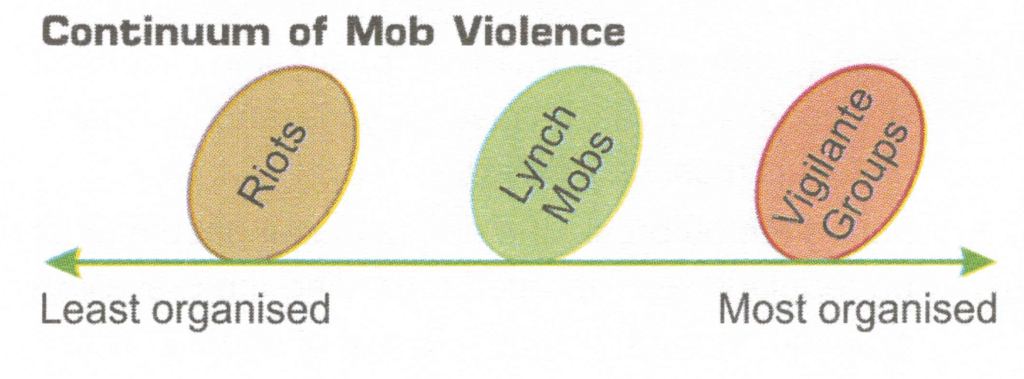
Mob Mentality
In his 1896 book, The Crowd – A Study of the Popular Mind’, Gustave Le Bon said that the most striking peculiarity presented by a psychological crowd is that whoever be the individuals that compose it, however like or unlike be their mode of life, their occupations, their character, or their intelligence, the fact that they have been transformed into a crowd puts them in possession of a sort of collective mind which makes them feel, think , and act in a manner quite different from that in which each individual of them would feel, think, and act were he in a state of isolation. Crowd participation extinguishes our normal psychological capacities and reveals a primal nature which is usually well hidden from view, he said. There are certain ideas and feelings which do not come into being, or do not transform themselves into acts except in the case of individuals forming a crowd.
Dr Michael Weiner, an associate professor of psychiatry at NYU School of Medicine, is of the opinion
that the lure to defy authorities might also encourage someone to engage in such behaviour. He says: “Mob violence, including looting, typically ignites with little planning. Many who join are young people attracted to excitement and the lure of defying authority. Typically, a small percentage of hardened criminal characters are found in mobs; they do have an important role in instigating the unbridled lawlessness and setting the vicious tone of its chaos. Alcohol is an important lubricant to fire-setting and other destructiveness for the sake of destroying.” One of the effective ways to eliminate mob violence, Weiner says, is to first identify it as criminality, rather than a social phenomenon.
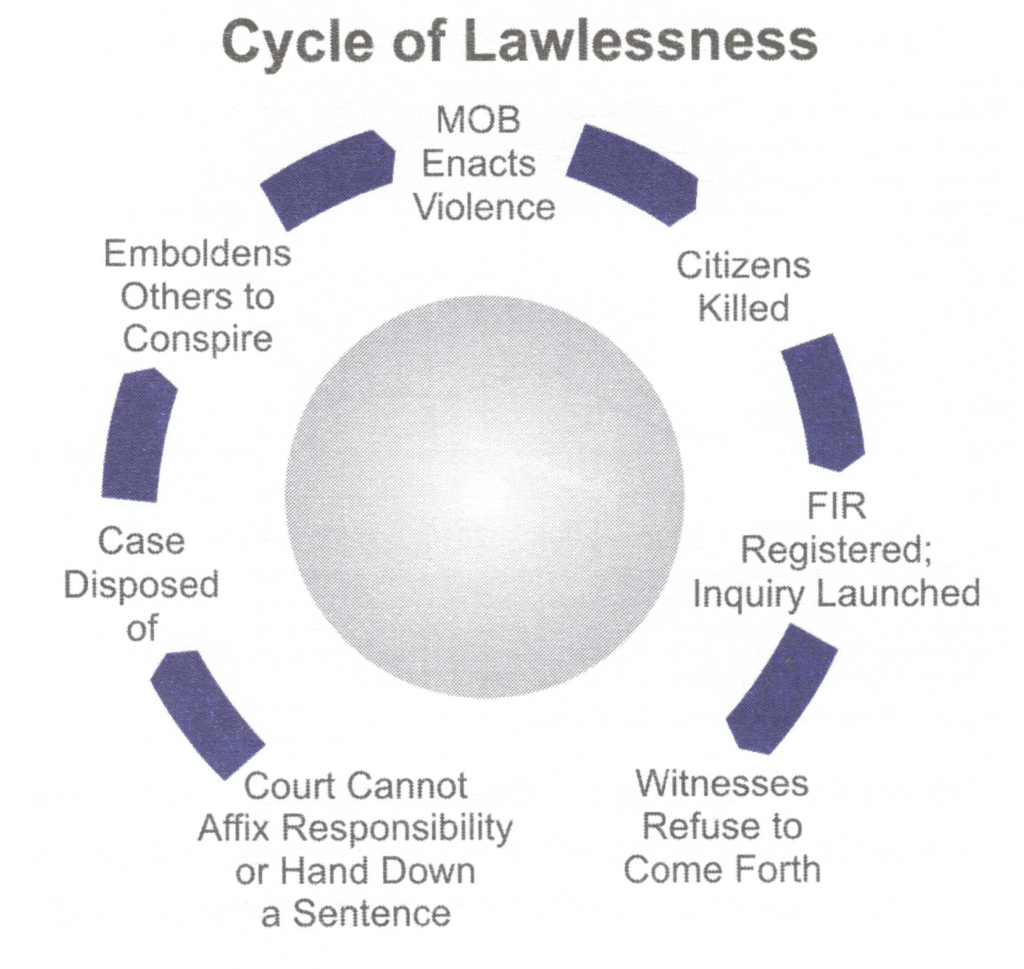
When mob violence goes unchecked, it feeds on itself leading to more and more severe violence being perpetrated by the mob. This cycle of lawlessness carries on, in the following way:
- Mob Violence in India has taken various forms in reaction to communalism, political instigation, crime and atrocities to the minority group, rape, murder, religious and cultural intolerance, racism, theft, etc. The public often employs destruction of public properties to show disagreement or disapproval of the government’s actions and policies. The basic element of mob violence is to work together to protect their communities, families, properties, power or privilege and inflict punishment or pain in order to deter future misconduct and deliver justice. The causes of mob violence in India are due to weak and time taking judicial system, corruption, high rate of crime, social diversity and lack of education. These bottlenecks urge the victims and their supporters to take the laws into their hands as they are denied justice. On the other hand, in the Indian society, people usually follow a certain set of ideals which are adamant to change.
Causes of Mob Violence
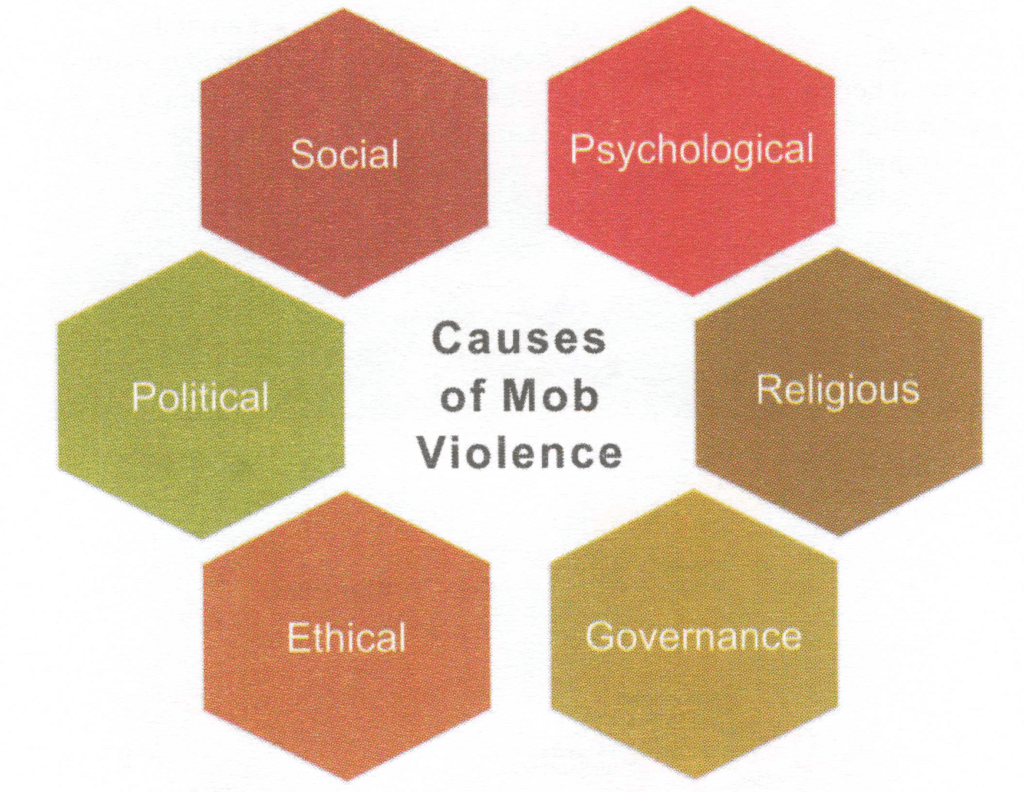
Social
- Vigilantism: If people don’t feel that they can trust the police to assist them, instead of taking the legal route, they take a mob type of format. Once you have a vigilante system, there aren’t mechanisms in place that protect the victim or perpetrator . The perpetrators of vigilantism do not have faith that the criminal justice system will effectively punish the alleged criminals. They often tend to see the police as unresponsive or corrupt.
- Cow-Vigilantism in India: In recent times, it has been observed in India that, there has been increase in the cases of cow-vigilantism. After the recent murder of a dairy trader, Pehlu Khan in Alwar, Rajasthan, by cow vigilantes on the Rajasthan-Haryana border, 11 deaths have been reported in 2017, the highest toll from cow-related hate crimes since 2010. The effects of hate crime are deeper and more wideranging than those of other serious crimes such as murders and assault. They impact not only the immediate victim but also the community with which the victim identifies, affecting social cohesion and stability. The data regarding cow vigilantism over the years is represented in graphs and pictures below. It is argued that, even in cases where those attacked may have been illegally smuggling cows for slaughter and tanning, the law does not allow a disproportionate response to the infraction. The civil society in India raised its concern regarding cow vigilantism and hate crime through a protest named #NotlnMyName. It was held in Delhi and several other cities across India on June 28 2017 by citizens against incidents of lynching of Muslims and Dalits, after the killing of 15-year-old Junaid Khan who was stabbed to death in Ballabhgarh, Haryana by a mob that mocked his skull cap and called him a beef eater after an argument over train seats escalated.
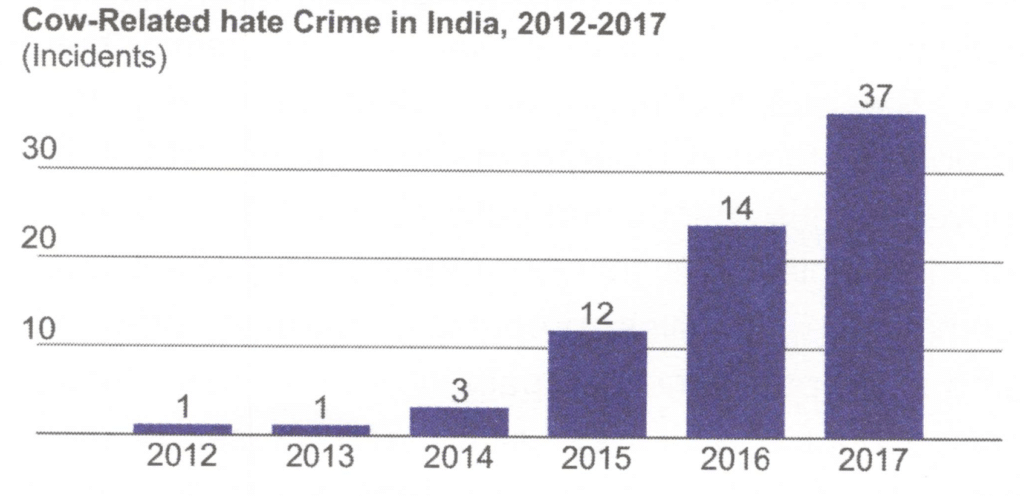
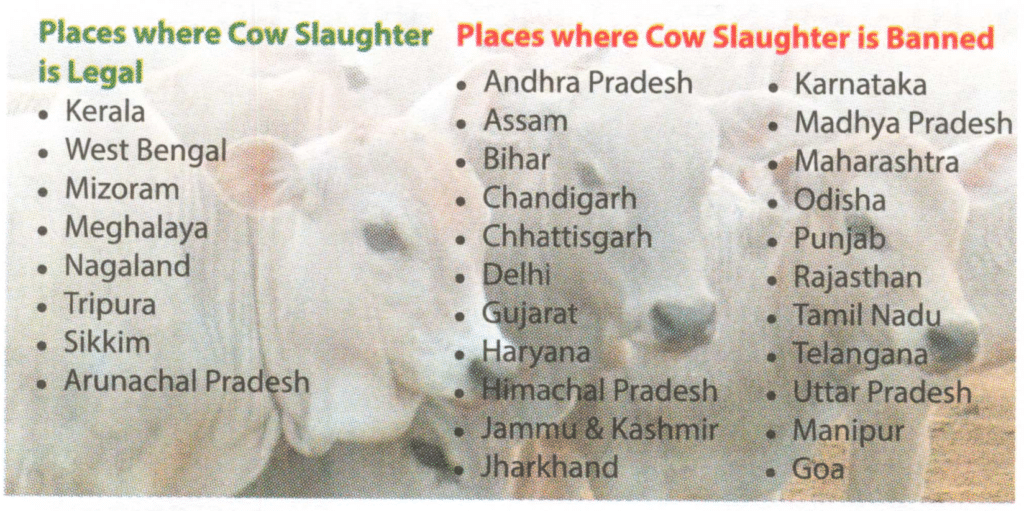
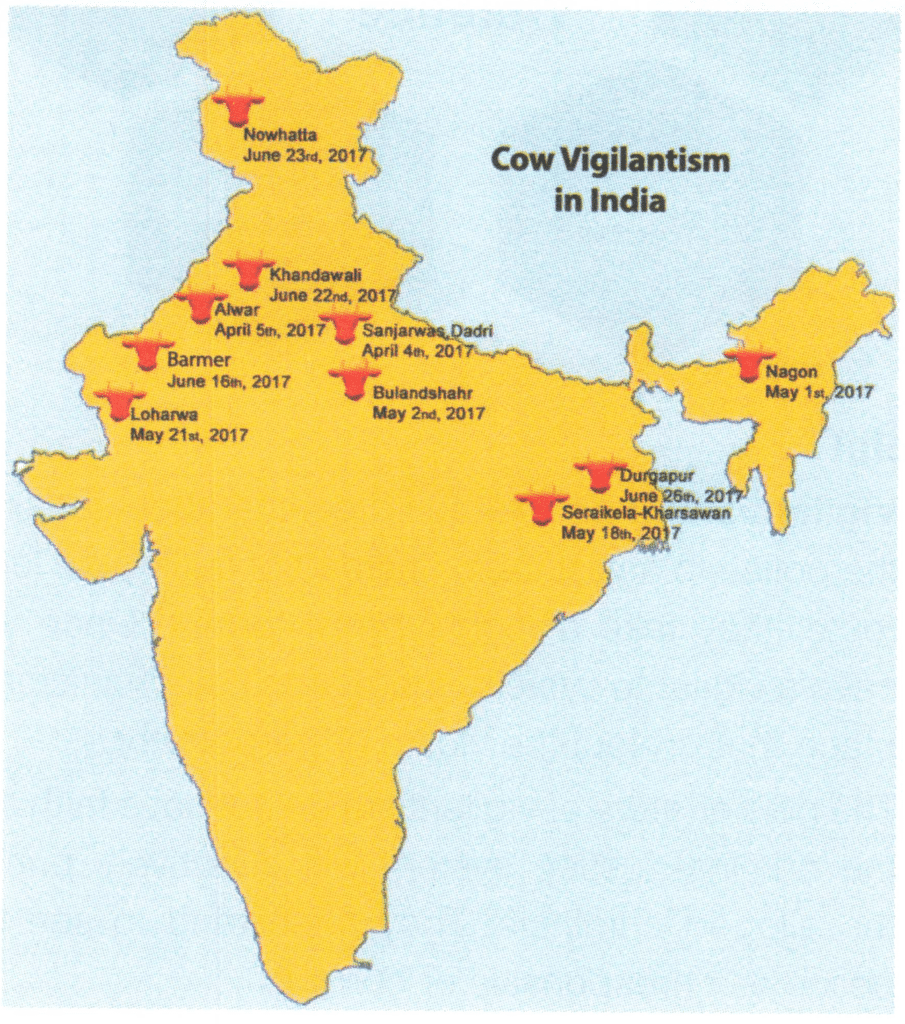
- Racial Hostility: This is one of the major causes of Mob Violence, where individuals of one race gather and attack the individuals belonging to the other race. It was most prevalent in United States between 1877 and 1950, where thousands of black people were the victims of lynching and racial violence. The lynching of African Americans during this era was a form of racial terrorism intended to intimidate black people and enforce racial hierarchy and segregation. In India, there have been instances of violence against people of North-East region in the metropolitan cities of Bengaluru, Delhi etc. The Supreme Court in Dec. 2016 passed a slew of directions, including setting up of a three-member panel, to enhance a sense of security and inclusion for people from northeastern states who faced racial violence and hate crimes. The court also told the government that the effective monitoring mechanism suggested by the M.P. Bezbaruah Committee in its report should be implemented.

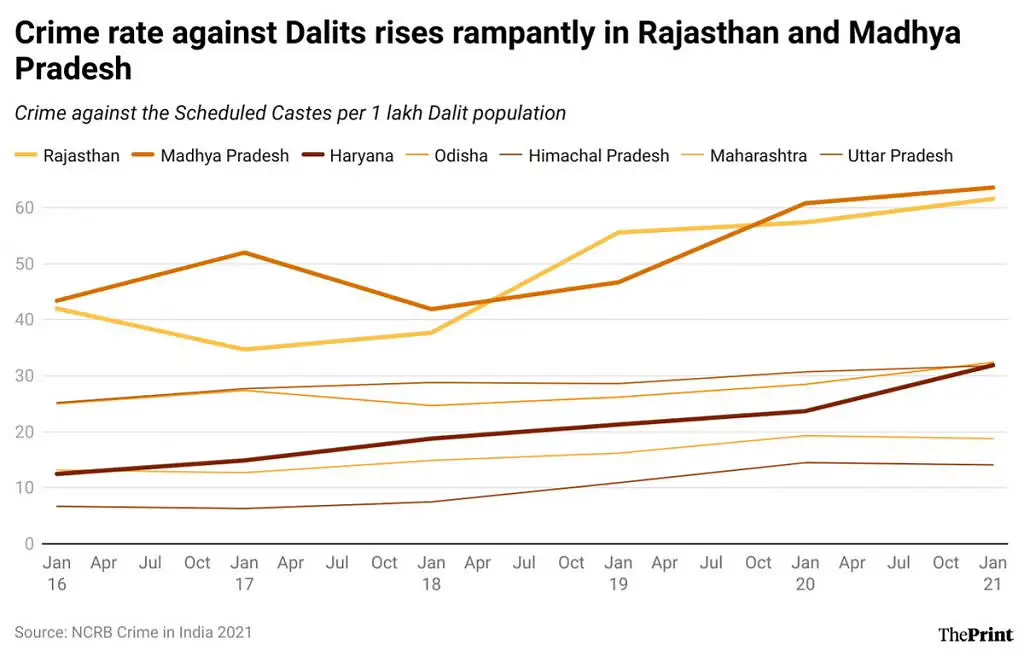
- Hostility between Communities: Hostilities between communities have been a major cause of concern for India. Violence between majority Hindu community and Muslims is far too common in India. In addition, India witnessed violence against Sikhs in 1984, against Christians there are also cases of frequent clashes. However, the Dalit community in India has to face maximum hostilities from the so called upper castes Brahmin or Rajputs. The National Crime Records Bureau (NCRB) reports a 44 per cent increase in violence against Dalits, up from 32,712 in 2010 to 47,064 crimes in 2014. In 2016, an estimated 214 incidents of crimes against scheduled castes (SCs) were reported per million SC populations, up from 207 the previous year, the NCRB data shows.
Psychological
- Power: Mobs feel empowered by the violence and destructiveness they unleash. Participating in large-scale violence can confer upon somebody intoxicating feelings of control, domination, and supremacy.
- Suggestibility: Many individuals in a mob may not be fully aware of what is going on or why, and so may be open to the answers provided by others who may appear to better know or understand the situation.
- De-individualisation: In groups, individual identity tends to be diffused into the larger collective identity. When combined with feelings of anonymity, participants may feel released from normal constraints on their behaviour.
- Conformity: Not only do individuals have a natural tendency to conform to the demands of a group, rioting mobs also have a tendency to attack and victimize those who resist or don’t conform, which tends to increase the pressures toward going along with the mob.
Political
- Parochial Interests: Political parties try to view everything through the prism of parochialism, and ‘political expediency’ remains their primary concern. In this way, several important issues like Mob Violence, which deserve lot of criticism and a strict NO from the political parties, hardly attracts strong words and actions from political parties. The people who are involved in the incidents of Mob Violence consider this a message of tacit approval from their parties. Further division in the sections of the society are useful for political parties and they exploit the conditions to the best of their capacity.
- Political Procrastination: Political procrastination refers to doing what is politically expedient leading to delaying timely preventative or corrective actions. The process includes sidestepping hard decisions by foot dragging and shifting the blame. The political parties in India are not condemning the mob violence enough. Instead, it is often seen that the political parties indulge in exploiting the fault lines in the society and keep people divided on issues of importance. Lack of political will and lack of action by the government or, patronage of a particular party fans the feeling to persecution against the minority community and the majority community gets embolden to carry out more heinous crimes against the minority community.
Religious
- Blasphemy: In some countries there is a law against Blasphemy, which could be define as, the action or offence of speaking sacrilegiously about God or sacred things. Blasphemy is subjective in nature and people are found to be very sensitive in the matter of religion. It is therefore not uncommon to see that, Mob indulges in violence to punish the person accused of blasphemy. For example, In July 2017 at Barishat, Bengal, during violent protests over a blasphemous Facebook post by a class 11 student, several dozen houses and shops of Hindus were vandalised and gutted, apart from nearly a dozen police vehicles that were torched.
- Religious Discord: Religious discord between Hindus and Muslims, Hindus and Sikhs and Hindus and Christians have been one of the causes behind the mob violence. This discord arises owing to the rigid and adamant belief of the one community seen in conflict with the believers of the other communities, e.g. certain Hindu communities rear Pig, which is abhorred by Muslim community. When there is a situation, the presence of detestable animal in Muslim community, around mosque, is caused by community member of other community, tensions flare and Mob violence is ensued.
- Religious Fundamentalism: Fundamentalism is an approach to a religion’s doctrine where its beliefs are enforced so strictly and literally that they are no longer compatible with the real-world as it is today. The uncompromising attitude is a psychological boost, and they will intentionally seek out areas of conflict between their own values and the values of those around them in order to publically highlight their own superior discipline. Fundamentalism causes the resolution of problems through centuries old religious laws. There have been instances of Mob involved in dispensing justice in the name of religious laws. e.g. in few countries like Pakistan, it is seen that the Mob breaking law to punish individuals who are found in violation of Islamic law.
Governance
- Deterioration in Law and Order: Law enforcement agencies in India lack competency, instruments, and training to handle such criminals and sensitive issues. During the investigations, they also don’t have enough resources and knowledge to collect evidence and present the cases in a holistic manner to the courts. Lack of evidences, lead to difficulty in the conviction of the accused. India’s judicial system and law enforcement agencies like police are incompetent and unpunctual. Mistrust with lack of confidence in the judicial system is the main reason of public indulgence in mob violence. In most of the cases in India, there is an inordinate delay at every stage in our criminal justice system. The legal system in India lacks transparency, bars interaction with the society. The delay in criminal justice causes more frustrations and people have to take necessary remedies to ensure their justice. This delay in meeting out justice further encourages wrong doers and ensures fruitful results of their wrongful actions. The victims or the opponents who are comparatively weaker will either compromise in terms dictated by the wrong doers or will lose all remedies.
- Lack of Legislative Provisions: India lacks an antilynching law to better deal with the Mob Violence. The groundswell of public disgust at the lynchings crystallised under the banner of the National Campaign Against Mob Lynching (NCAML), which has initiated a campaign for a law against mob lynching also known as ‘Masuka’, short for Manav Suraksha Kanoon (law to protect humans). The primary argument of the activists and lawyers advocating an anti-lynching law is that it fills a void in our criminal jurisprudence. It is true that at present there is no law that criminalises mob killings. The Indian Penal Code has provisions for unlawful assembly, rioting, and murder but nothing that takes cognisance of a group of people coming together to kill (a lynch mob). It is possible, under Section 223 (a) of the Criminal Procedure Code (CrPC), to prosecute together two or more people accused of the same offence committed in the course of the “same transaction”. But the provision falls far short of an adequate legal framework for prosecuting lynch mobs. The NCAML’s draft Protection from Lynching Act, 2017 defines, for the first time in Indian legal history, the terms ‘lynching’, ‘mob’ and ‘victim’ of mob lynching. It makes lynching a non-bailable offence, criminalises dereliction of duty by a policeman, criminalises incitement on social media, and stipulates that adequate compensation be paid, within a definite time frame, to victims and survivors. It also guarantees a speedy trial and witness protection.
Ethical
Mob violence reflects the malaise prevalent in the society and put a question mark on the conscience of the society. There are various ethical dimensions related to Mob violence, which could be represented in a tabular form as:
| Values | Description |
|---|---|
| Rule of Law Violated | Only legitimate authority can give punishment after legal process thus those who lynched the man have violated rule of law. |
| Against Constitution | Constitution aims to provide Justice social, economic and political-mob violence goes against the constitutional values. |
| Human Rights Violations | Killing a person is against the human rights of a person and against UNHRC charter. |
| Against Non-Violence Virtue | Mahatma Gandhi’s virtue of nonviolence is diminishing in the society; Mob is involved in killing poor, downtrodden without any sympathy for human life. |
| Lack of Compassion | In the modern times there is lack of compassion towards poor and marginalised. |
| Absence of Tolerance | People who lynch the man have less tolerance towards other man, which is against the humanism. |
Consequences of Mob Violence
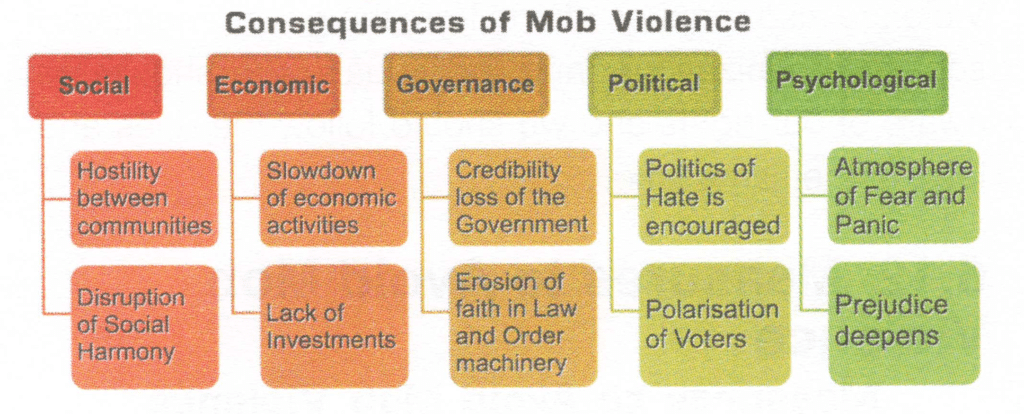
Social
- Disruption of Social Harmony: The social fabric of the society gets irreparably damaged and the conditions of mistrust serve as a catalyst for future conflicts on flimsy grounds. The values of religious tolerance, universal brother-hood etc., that were envisioned by the founding fathers of the nation; and are integral part of the constitution, are threatened.
- Hostility between Communities: The antinational elements get adequate opportunity to fan anti national feelings and work on creating an atmosphere to break the cohesiveness of our society. This leads to further acerbation of hostile feeling between communities and prepares a fertile ground for further clashes and hostilities.
Economic
- Lack of Investments: The atmosphere of uncertainty and internal turmoil created by Mob Violence dissuades the foreign investors to set up their businesses in India. An April 2016, Pew Research Center analysis of 198 countries, ranked India as the fourth worst in the world for religious intolerance. Such reports are closely monitored by international business community and may have an adverse effect on the investment plans of multinational and trans-national organisations.
- Slowdown of Economic Activities: Increase in the case of Mob Violence causes an adverse effect on the economic activities. Shops owners in area may fear for their survival as the behaviour of Mob cannot be predicted. This could be underscored further by the incidents of London Mob Violence in 2011, where the Mob indulged in looting items from the shops and causing widespread arson and rioting .
Governance
- Erosion of faith in Law and Order Machinery: Lawlessness accruing out of Mob Violence is exploited by the divisive forces operating in the country because of which internal security risks gets heightens. There is an avoidable loss of life and essential public property gets damaged. It lends to hooliganism, and the situation is often exploited by anti-social elements by plundering and indulging in activities only for their personal gains.
- Credibility Loss by the Government: To check the menace of Mob violence, Government needs to deploy more forces. Deployment of large scale security forces dissipates the state exchequer and may result in occasional Human Rights abuses. The Human Development Index of the society is adversely affected by these hampering restrictions that are laid on the basic right to freedom of people.
Political
- Polarisation of Voters: Political parties can exploit the fragile nature of Indian society by polarisation of voters on communal lines. Some experts have argued that, in the aftermath of Muzaffarnagar riots in 2013, in western Uttar Pradesh, the communal atmosphere exacerbated, even in the rural areas. A clear shift in the voting preferences happened. Thus, polarisation of communities on religious line on one hand provides the political party easy access to votes, on other hand shifts the attention of voters to trivial and emotional issues, rather than on important issues such as governance.
- Politics of Hate: Mob violence is not an unheard form of politics in India. Performing anger, destroying public property, ransacking offices of opponents and media outlets, beating up opponents are all techniques of popular politics in India. Shiv Sena and its supporters turned mob violence and threat of violence into an effective language of daily politics in Mumbai in 1990s.
Psychological
- Atmosphere of Fear and Panic: Mob Violence creates an atmosphere that is not contributing to democracy, liberty and fraternity. India is witnessing different incidents of mob violence in the form of lynching of innocent people by the vigilante groups in different parts of the country. People of a particular community are living in fear and panic . Whether it is Akhlaq’s lynching on the pretext of storing cow’s meet in his refrigerator, or Pehlu Khan on the suspicion of smuggling cow, the examples of targeted violence has created a sense of fear in a community vis-a-vis Mob violence.
- Prejudice Deepens: Prejudice is the cause as well as effect of Mob Violence. Prejudice against a particular community, causes lack of communications, setting up of irrational beliefs, suspicion and consequently leading to hostile behaviour. The targeted community responds to the hostile behaviour in the same currency, leading to further deepening of the prejudice. This phenomenon is increasingly seen in Mob Violence incidents across India.
Conclusion
In a democratic country like India, mob violence will not work in a long run. It will only increase the chaos and cause more obstruction to the peace, law, and order of the nation. The rule of law has already been established and if there is any recommendation for changes, we should go through the proper channels of institutional reforms.
The liberty and equality rights of people are violated by Mob Violence. Minority and Individual rights are often neglected in our democracy . Mob violence is one of the instruments used to exploit these vulnerable groups. Breakdown of civil order is common in Mob Violence. Law and order in a democracy are based on rules and procedures that have been put in first place to ensure free and fair trials. The success of democracy also depends on the faith of the citizenry in the rule of law and it will perish when a disgruntled citizen turns to demagogic dictators who promise justice. Human rights are neither earned nor inherited. They are possessed by everybody in the world because we are human beings. People are equally entitled to them without any discrimination. It is the constitutional and moral perspective for the protection of human rights of every citizen in this country. Mob violence needs to be controlled because it undermines the rule of law.
Martin Luther King rightly said in his statement: “Injustice anywhere is a threat to justice everywhere”, not to commit any injustice to anyone including victims and accused of any cases. Various causes related to poverty, unemployment, and social discrimination need to be taken care of by the government and society. Justice and police should be accessible by everybody in this country. So, we have to combat Mob Violence and bring changes in our ways of dealing with criminals. Spreading awareness of human rights, improving the justice system and accountability, educating and uplifting the social and economically weak sections will help in combating Mob Violence. Eliminating Mob Violence also requires efforts from the government, civil society organizations, and individuals. We should be aware of our rights and we should follow the rules and laws at the same time.
Measures to Avoid Mob Violence
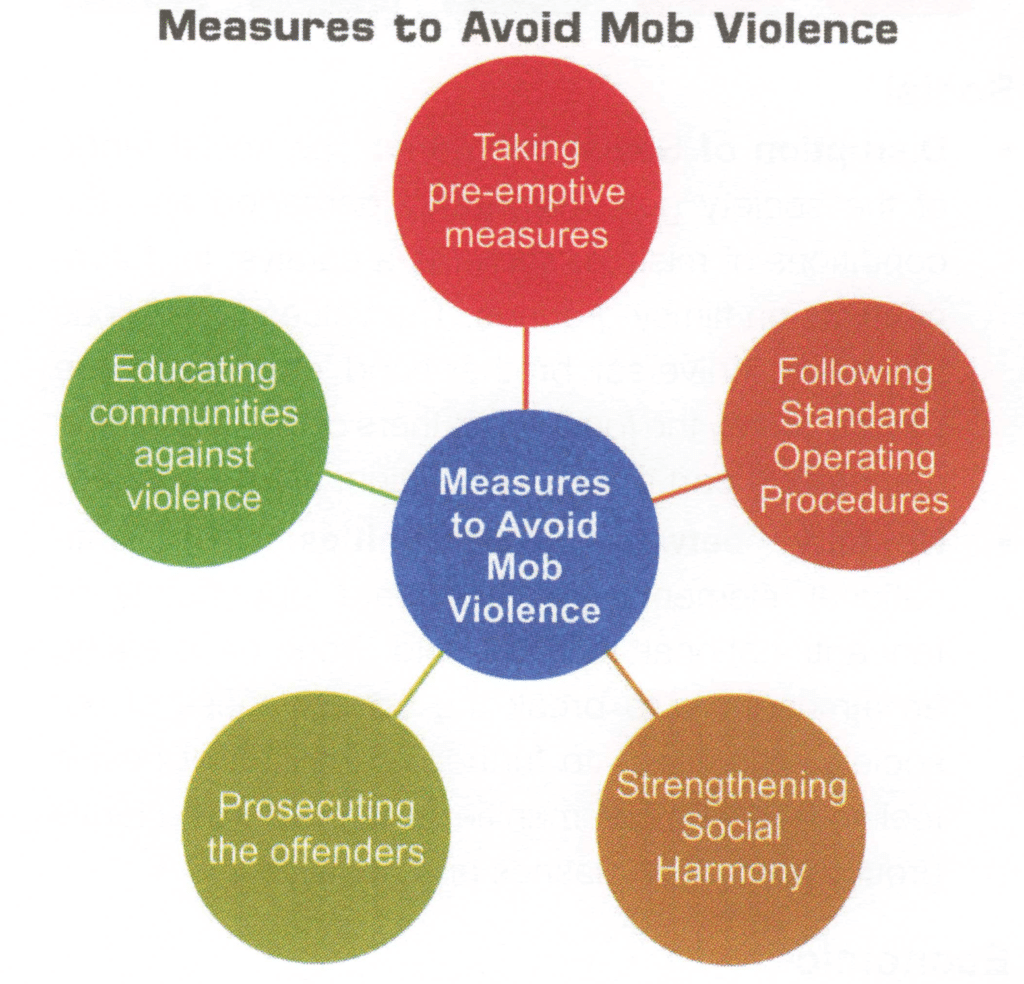
The maintenance of communal harmony, and the prevention/avoidance of Mob Violence/riots and, in the event of any such disturbance occurring, action to control the same and measure to provide protection and relief to the affected person, is the prime responsibility of the state governments.
Taking pre-emptive Measures
- Strengthening the Intelligence: Special attention needs to be given to developing mechanisms for intelligence and information gathering, and suitably integrating them with the response mechanism. The intelligence feedback, especially from the ground level, should be effectively made use of by the administration. The district administration also needs to develop independent sources of intelligence as such sources will have higher credibility. Intelligence report should be sent to the subdivisional/district level by each police station in hyper-sensitive/sensitive areas, and the situation should be reviewed on a monthly basis at the level of District Magistrate and Superintendent of Police.
- Acting Swiftly on Inputs: In the event of any incident the administration should act on the inputs available without any delay. It was seen in Panchkula incident in August 2017, that the administration acted a bit late in making sure the gathered mob did not become violent.
- Enforcing Section 144: Section 144 of CrPc, which prohibits the assembly of four or more people, has to be imposed in areas where miscreants are supposed to gather. This will help the administration to avoid accumulation of people at one place, reducing the chances for mob violence.
- Communication and Mobilisation Should be Quick: The communication lines of the law and order machinery should be intact; to make sure necessary reinforcements are sent to the places where they are needed most without delay. The arterial routes should be in the control of administration at all times to mobilise the force effectively and quickly.
Standard Operating Procedures
The administration should develop Standard Operating Procedures to deal with the situation of Mob Violence/communal clashes resolutely and effectively. Administrative lapses could be minimised when the law and order agencies are aware of what sequence of steps to be followed and how response should be calibrated.
Containing the Situation
The prime responsibility of the law-enforcement agencies is to avoid the spill over effect to other areas. Miscreants should be overcome by power as quickly as possible.
Providing the Exit Route to Miscreants Away
When mob is on rampage, certain routes should be blocked and the mob should be provided exit route which are away from city or important areas to minimise the damage.
Avoiding Loss of Life and Property
The first-aid and medical facilities to the injured should be provided to minimise the loss of life.
Medical Relief Teams should be constituted in such a manner that, as far as possible, members of various communities are represented in it. The team should not only be technically competent but should have the qualities of sincerity and empathy for the victims.
Strengthening Social Harmony
The recent rise in the incidents related to communal and mob violence could be attributed to the decline in the social harmony in the country. To overcome the challenges of mob violence the interaction between communities should be increased.
The civil society as well as the administration should organise events that enhance social harmony. When suspicion among the members of the community gives way to confidence for the other community members the incidents of mob violence will be stopped.
Educating Communities Against Violence
Awareness campaigns about the problems of other communities could be organised with the help of NGOs to underscore the fact that the biggest enemy is in the form of poverty, unemployment, hunger etc., rather than different communities as reiterated by Prime Minister Modi.
Extensive educational programmes should be conducted in school so that the prevalent hatred is not passed on to the future generations and students learn to respect all religion, become tolerant of diversity and realise the dream of India free, which is free from hatred.
Prosecuting the Offenders
Prosecution of all offences relating to mob violence/rioting should be carefully monitored and, wherever necessary, special investigation teams (SIT) may be constituted for ensuring fair and impartial investigation. The State Government concerned may consider appointing Special Public Prosecutors for proper prosecution of the above cases, which should be vigorously pursued.
Supreme Court’s Prescription to end Mob Lynching
Supreme Court gave 11 point prescription to end mob lynching. These directions, include preventive, remedial and punitive steps, to deal with the crime:
- The state governments shall designate a senior police officer in each district for taking measures to prevent incidents of mob violence and lynching.
- The state governments shall immediately identify districts, sub-divisions and villages where instances of lynching and mob violence have been reported in the recent past.
- The nodal officers shall bring to the notice of the DGP any inter-district co-ordination issues for devising a strategy to tackle lynching and mob violence related issues.
- It shall be the duty of every police officer to cause a mob to disperse, which, in his opinion, has a tendency to cause violence in the disguise of vigilantism or otherwise
- Central and the state governments should broadcast on radio and television and other media platforms including the official websites that lynching and mob violence shall invite serious consequence.
- Curb and stop dissemination of irresponsible and explosive messages, videos and other material on various social media platforms. Register FIR under relevant provisions of law against persons who disseminate such messages.
- Ensure that there is no further harassment of the family members of the victims.
- State governments shall prepare a lynching/mob violence victim compensation scheme.
- Cases of lynching and mob violence shall be specifically tried by designated court/fast track courts earmarked for that purpose in each district. The trial shall preferably be concluded within six months.
- To set a stern example in cases of mob violence and lynching, the trial court must ordinarily award maximum sentence upon conviction of the accused person.
- If it is found that a police officer or an officer of the district administration has failed to fulfill his duty, it will be considered as an act of deliberate negligence.

Well